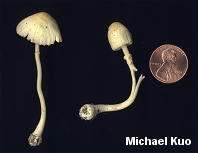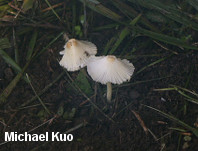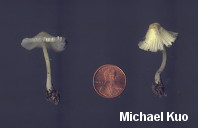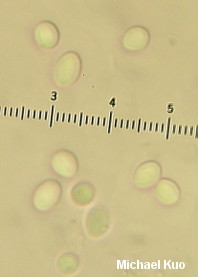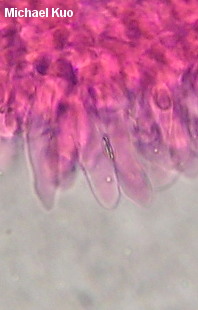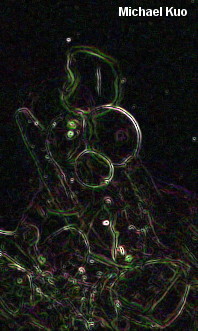| Major Groups > Gilled Mushrooms > Pale-Spored > Lepiotoid Mushrooms > Leucocoprinus flavescens |

|
Leucocoprinus flavescens [ Basidiomycota > Agaricales > Agaricaceae > Leucocoprinus . . . ] by Michael Kuo Leucocoprinus flavescens is a tiny, pale yellow lepiotoid mushroom, similar to Leucocoprinus birnbaumii but with a paler cap that features a brownish center, and substantially smaller spores. The species was originally described by Morgan (1907) from an Ohio collection made under black locust and honey locust, and it has since been recorded from greenhouses in Massachusetts and California. I have made two collections in Illinois that appear to match Leucocoprinus flavescens: one in woods dominated by black locust and one in grass next to my house, under the drip of an air conditioner, with a large honey locust tree 30 feet away. Leucocoprinus flavescens may simply be a synonym of Leucocoprinus straminellus (better known by its former name, Leucocoprinus denudatus), but the latter mushroom has a yellow, rather than pale brown, cap center, and its spores are usually slightly larger. Lepiota flavescens is a synonym. Description: Ecology: Saprobic; growing alone or scattered in the vicinity of black locust or honey locust; also reported from greenhouses; summer; distribution uncertain. The illustrated and described collections are from Illinois. Cap: 1-2.5 cm; egg-shaped when young, becoming bell-shaped to broadly convex or nearly flat at maturity, but retaining a central bump; dry; grooved from the margin to the central "eye"; powdery or very finely scaly where grooved; bald over the center; light greenish yellow except for the brownish to tawny brown center. Gills: Free from the stem; close; short-gills infrequent; white with a yellowish cast, or yellowish. Stem: 20-60 mm long; 1-2 mm thick; more or less equal above, but with a swollen base; pale yellow; sometimes discoloring reddish brown; when fresh and young covered with tiny powdery scales, but soon bald; with a yellowish, bracelet-like ring on the upper stem that sometimes disappears; basal mycelium white. Flesh: Whitish to pale yellow; very thin. Odor and Taste: Odor not distinctive; taste bitter. Chemical Reactions: KOH negative on cap surface. Spore Print: White. Microscopic Features: Spores 4-6.5 x 3.5-4.5 µ; ellipsoid to broadly ellipsoid or nearly subglobose; without a pore; smooth; thick-walled; hyaline in KOH; golden to tawny yellow in Melzer's. Cheilocystidia 35-50 x 7.5-10 µ; widely cylindric to clavate, subclavate, subutriform, or subfusiform; hyaline in KOH; thin-walled. Pleurocystidia not found. Pileipellis with inflated (10-35 µ), subglobose cells over the disc (young specimens) and scattered among the striae (often difficult to find). REFERENCES: (Morgan, 1907) H. V. Smith, 1981. (Smith & Rea, 1944; Kauffman, 1924; Smith, Smith & Weber, 1979; H. V. Smith, 1981; H. V. Smith & Weber, 1982.) Herb. Kuo 08050201, 08190501. This site contains no information about the edibility or toxicity of mushrooms. |
© MushroomExpert.Com |
|
Cite this page as: Kuo, M. (2015, August). Leucocoprinus flavescens. Retrieved from the MushroomExpert.Com Web site: http://www.mushroomexpert.com/leucocoprinus_flavescens.html |
